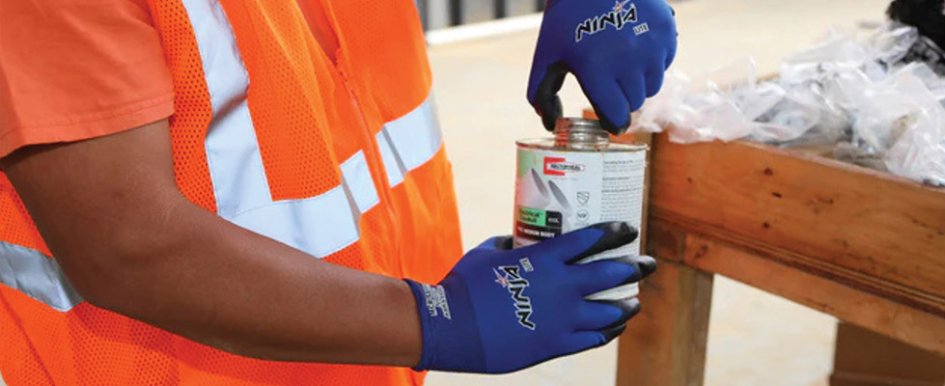
As environmental concerns, regulatory pressures and shifting consumer expectations drive industries to embrace more sustainable practices, general contractors are increasingly expected to integrate eco-conscious strategies into their operations. This shift reflects a broader societal movement, where environmental stewardship is becoming a crucial aspect of a company’s value proposition. In 2020, 92% of S&P 500 companies published sustainability reports. To put this into perspective, only 20% of the S&P 500 companies published sustainability reports in 2011.
One way construction companies can contribute to their sustainability goals is by incorporating eco-friendly personal protective equipment (PPE) into their operations. For some context, traditional safety gloves are often made from synthetic materials derived from petrochemicals, such as nitrile and vinyl. These non-biodegradable materials can persist in landfills for centuries. Additionally, they usually involve energy-intensive production processes, chemical and microplastic pollution, and recycling challenges.
So, while it may seem minute in the grand scheme of things, choosing eco-friendly work gloves can have a ripple effect in supporting a more environmentally responsible industry.
What Makes Work Gloves Eco-Friendly?
The term “eco-friendly” encompasses products designed to minimize their environmental impact throughout their life cycle, from production to disposal. For work gloves, this translates the following key considerations:
Manufacturing: Low-Impact Production
Eco-friendly products won’t truly benefit the planet if their production continues to cause environmental harm. As such, sustainable glove manufacturers are focusing on reducing energy consumption, carbon dioxide (CO2) emissions and water usage throughout production. While many are gradually transitioning to renewable energy sources to minimize their dependence on fossil fuels, more forward-thinking companies are actively monitoring, collecting and treating exhaust gases to curb emissions and, where applicable, converting them into recyclable heat energy to power other processes.
Meanwhile, pioneering companies are adopting life-cycle assessments (LCA) to evaluate and improve the environmental impact of their gloves. By identifying energy hot spots or wasteful stages in production, these assessments allow companies to implement targeted improvements, such as streamlining logistics or optimizing material use. In embracing such holistic strategies, manufacturers not only reduce their ecological footprint but also pave the way for setting new industry benchmarks for sustainable practices.
Packaging: Thoughtful & Minimal
The journey toward sustainability doesn’t end with the product itself. Many eco-friendly brands are using recyclable, compostable or minimal packaging materials for elements such as master cards, hang tags and cartons. By reducing excess packaging and incorporating lightweight materials, brands save hundreds of trees from being used for paper consumption and lower carbon emissions associated with manufacturing and transport.
.png)
Are Eco-Friendly Work Gloves Any Good?
One of the biggest concerns when transitioning to sustainable PPE is whether eco-friendly options can match the performance and affordability of traditional solutions. Historically, “green” products were associated with lower durability and higher costs, deterring many businesses from exploring more sustainable alternatives. Fortunately, advancements in sustainable manufacturing have helped reshape this perception.
Today, eco-friendly gloves are engineered to meet — or even exceed — the durability, grip and protection offered by their conventional counterparts. Many are made using high-quality materials such as recycled fibers, biodegradable latex and plant-based alternatives, which maintain the robustness needed for tough jobs.
Examples include the following:
- Biodegradable nitrile — While traditional nitrile gloves are known for their durability, they’re also notoriously slow to decompose. Biodegradable nitrile incorporates organic additives that enable microbial activity to break down the material faster in anaerobic landfill environments.
- Recycled polyester — Made from post-consumer plastic bottles, recycled polyester delivers exceptional durability and moisture resistance. It is ideal for heavy-duty work gloves designed for demanding environments, including wet and rugged conditions.
- Bamboo fiber — Sustainably harvested bamboo provides a naturally antibacterial, moisture-wicking and biodegradable fiber, perfect for lightweight, comfortable work gloves. Its rapid growth eliminates the need for pesticides, making it a responsible choice for workers and the environment.
- Compostable materials — The development of bioplastics like polylactic acid (PLA) and polyhydroxyalkanoate (PHA) represents a significant advancement in sustainable glove manufacturing. Sourced from renewable plant-based materials, these innovative materials are fully compostable under industrial conditions, offering a responsible end-of-life solution.
Apart from single-use solutions, many eco-friendly gloves also boast longer lifespans. This translates to a lower total cost of ownership, making them a cost-effective and responsible choice for businesses aiming to adopt greener practices.
How to Determine If Work Gloves Are Eco-Friendly
Look for products that specify their material sources, particularly those using renewable or recycled components. Certifications like Global Organic Textile Standard (GOTS) or Forest Stewardship Council (FSC) indicate responsible material sourcing, while Cradle to Cradle, OEKO-TEX or fair trade indicate the gloves meet specific environmental and ethical standards.
If the packaging mentions the use of renewable energy, advanced water recycling systems or reduced chemical consumption, it’s a positive sign of their commitment to sustainability. Many companies also share their sustainability commitments and achievements publicly. A quick search of the brand’s website or sustainability report can reveal their approach to sourcing, manufacturing and packaging, as well as any targets they’ve set for reducing their ecological footprint.
Beyond PPE: A Holistic Approach to Sustainability
While highlighting public-facing sustainability goals is becoming increasingly common, true progress depends on aligning internal operations with these commitments. Businesses serious about making an impact should consider integrating sustainability into every aspect of their operations.
The challenge lies in balancing traditional initiatives — like reducing paper use and implementing waste reduction programs — with deeper systemic changes such as lowering carbon emissions and optimizing resource efficiency. These efforts require significant investment and coordination across procurement, production, logistics and workforce engagement, all while managing budget constraints and economic pressures.
Eco-friendly work gloves offer a small yet impactful step toward sustainability. However, true environmental responsibility extends beyond these isolated choices. Companies can adopt a comprehensive strategy, reexamining every aspect of their operations to drive meaningful change. By embedding sustainability into core business practices, organizations can meet ambitious goals while reinforcing stakeholder confidence and industry leadership.
